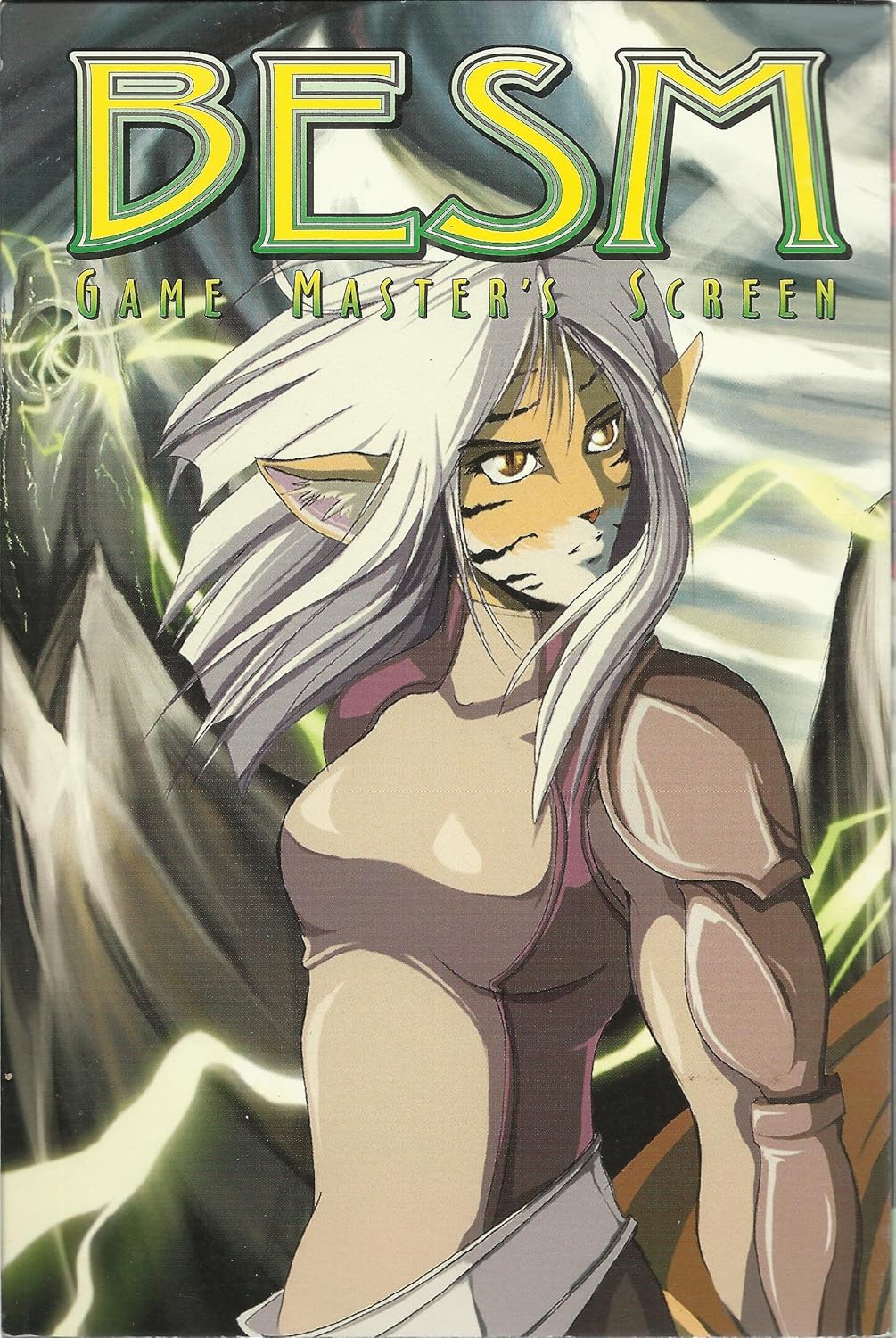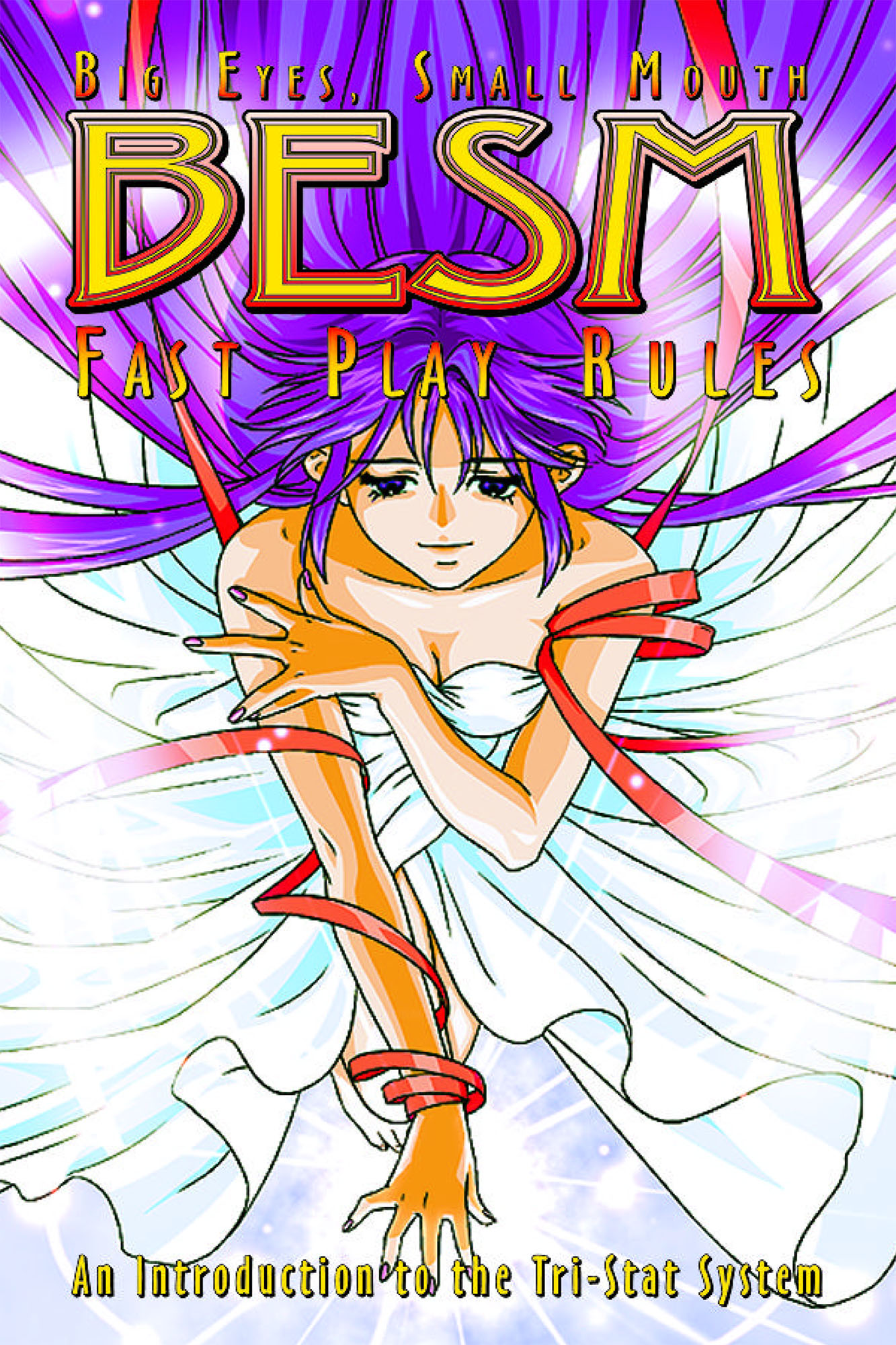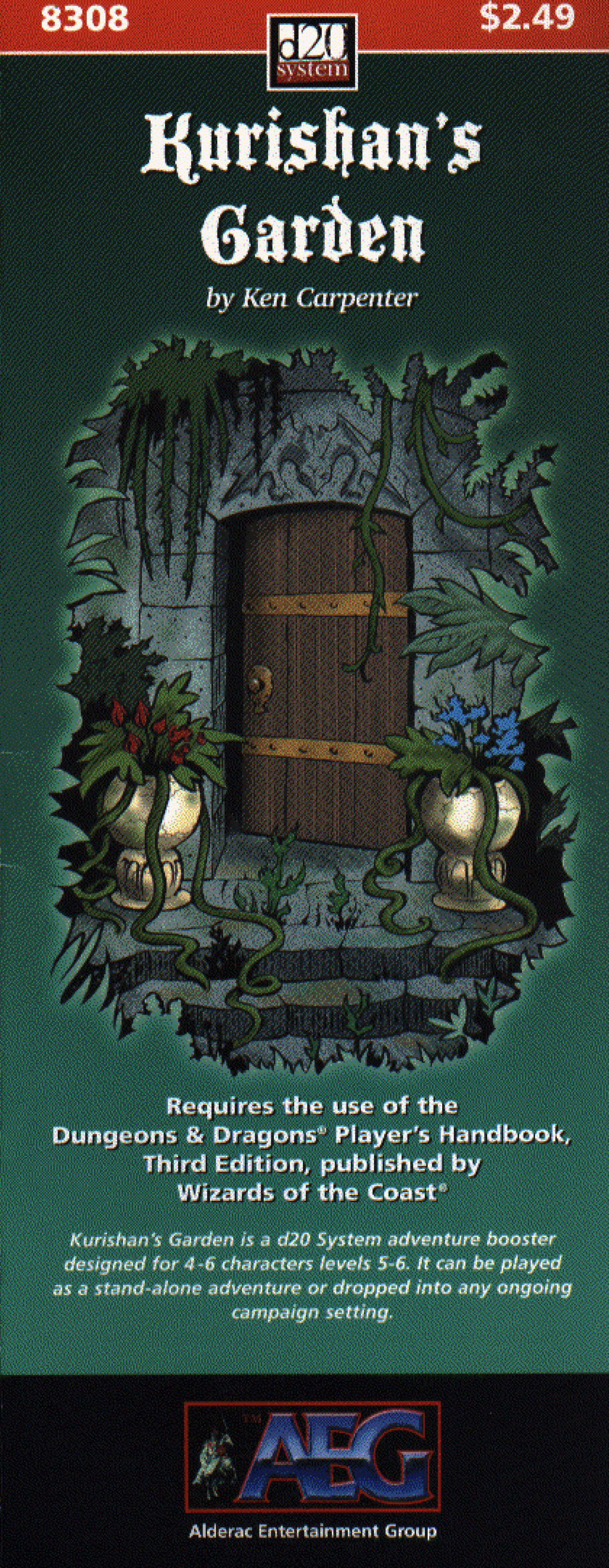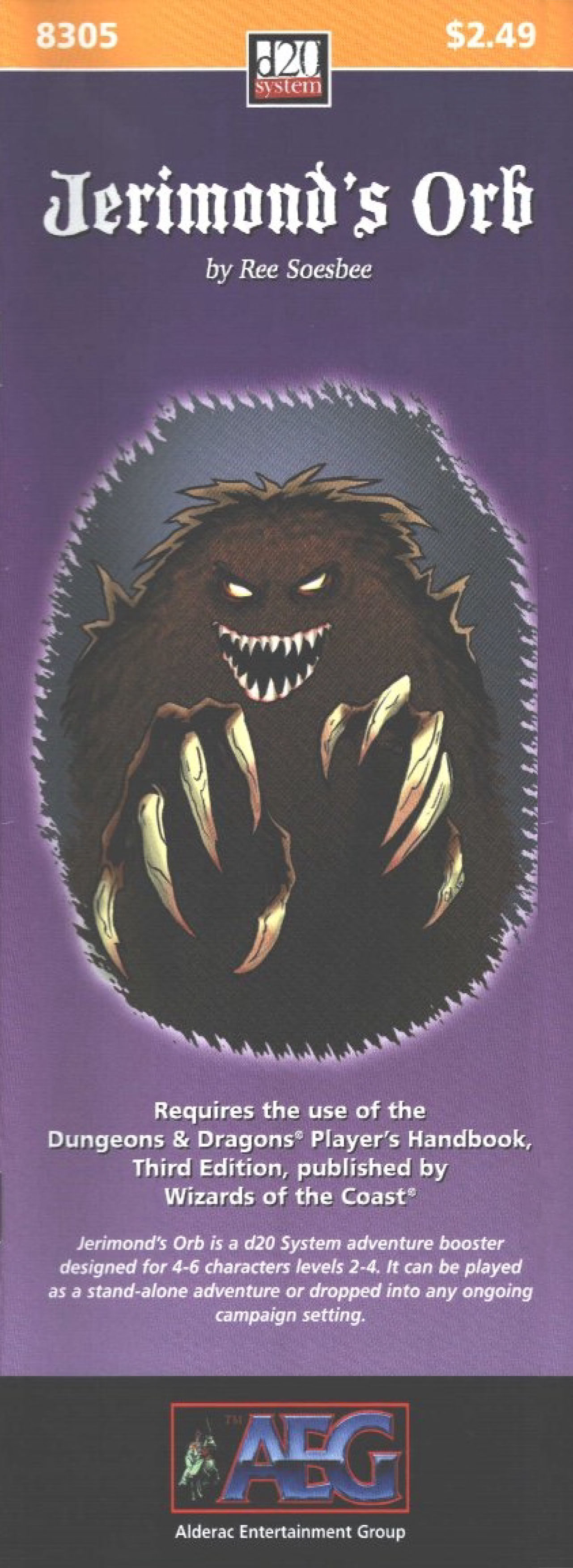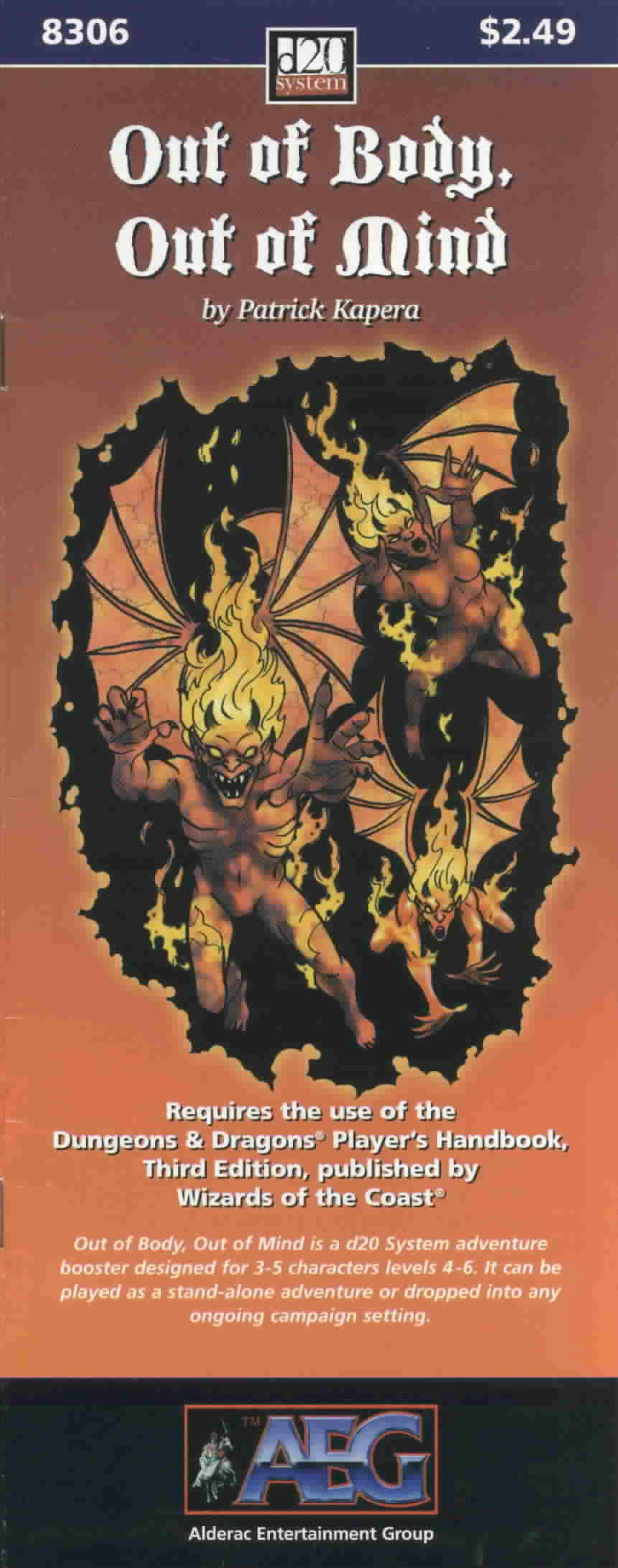High quality artwork on a GM screen packaged with an excellent starter adventure for Big Eyes, Small Mouth. This one gets two thumbs up from me.
Review Originally Published May 21st, 2001
GM screens invariably follow the same pattern: You’ve got a trifold or quadfold piece of cardboard with art on one side and relevant statistics on the other. This is almost certainly packaged with some sort of pamphlet, which is usually included in a vain attempt to convince people that the piece of cardboard is actually worth the exorbitant price which is being charged for it.
(You know, I can’t figure out why they don’t just package the GM screen with the character sheets.)
The Big Eyes, Small Mouth GM Screen certainly fits this pattern: Quadfold cardboard (with each fold having the same dimensions as the rest of the BESM product line), with an accompanying cross-genre adventure module: So, We Have… An Obelisk?
THE SCREEN
The screen itself focuses primarily on combat – at points seeming to go out of its way trying to find relevant charts (for example, half a page is spent detailing the differences between the six skill levels – which come down to the fact that skill level 6 has a -6 bonus and a skill level 5 has a -5 bonus). As a result, I feel that it overlooks other charts and information which would have been more useful. This is a fairly typical failure of GM screens, and one of the reasons I don’t generally like them – although the BESM screen at least avoids the silliness of including character creation rules (which you’re almost never going to have to reference during actual gameplay).
The art on the opposite side is a stunning piece of full-color fantasy art by Julie Dillon, an artist who should already be familiar to any BESM fan. Dillon’s art continues to impress me in its ability to conjure forth epic and awe-inspiring vistas with dynamic and varied characters. The quality of the art alone has probably earned this screen a place at my game table. (Oddly, I’ll probably end up using it for my upcoming D&D campaign, actually).
When I first saw the screen I was initially concerned about the decision to have it mirror the dimensions of the BESM books. The shorter height, at some game tables, will reduce the usefulness of the screen as a screen. But in actual practice I didn’t find this to be a problem except in the rare circumstance where the table being used was abnormally low compared to the players sitting around it.
THE ADVENTURE
Opening Scene: The PCs’ homeworlds are utterly destroyed and they die.
If nothing else, that’s certainly a catchy way of starting an adventure – and gives the players a great deal of flexibility in creating their characters (since it allows them to draw from any genre or setting they can conceive of and the GM is willing to approve).
Of course, shortly after they die they find themselves summoned by a disembodied voice, whereupon they appear upon a dusty, ruined road which runs along the edge of a tent village which has been raised in the shadow of a giant obelisk… just like the obelisks which led to the destruction of their own worlds.
Here’s what’s going on: In one of the many dimensions of the multiverse, a corrupt America has discovered the secret of draining other dimensions of their energy – granting themselves eternity and immortality, but robbing trillions of their lives. They accomplish this through the use of the obelisks. The PCs are faced with the difficult task of saving this world from destruction.
The tent village in which they have appeared has been formed at the command of the Teacher, a seeming messiah who preaches that the obelisk is a tool of the gods – sent to test their followers for their strength and faith. In truth, the Teacher is an agent of the dimension which controls the obelisks – and is using his position to complete the draining process on this world.
Assuming that the PCs can pierce through the Teacher’s facade and prevent him from bringing about armageddon on this world, they will find themselves teleported to the homeworld of the obelisks. There they have an opportunity to end this horrific interdimensional genocide forever – but not without a twist: They can end the genocide, but only by wreaking havoc on multiple worlds themselves. On the other hand, they can make a deal with a devil and see their homeworlds restored as new frontiers for the Empire.
The concept is bold and daring, and Jesse Scoble, the author, succeeds at investing it with memorable characters and powerful scenes. Every so often you get an adventure which makes you want to jump up and start gaming right away: In my opinion, this is one of them.
CONCLUSION
The screen’s content is of average quality. The screen’s artwork is stunning. The adventure included with the screen is excellent, and can easily serve as either an exciting one-shot or as the foundation for a highly memorable and entertaining campaign.
This one gets two thumbs up from me.
Style: 4
Substance: 4
Authors: Jesse Scoble
Company: Guardians of Order
Line: Big Eyes, Small Mouth
Price: $12.95
ISBN: 1-894525-12-4
Production Code: 02-102
Pages: 50
I never actually got a chance to run So, We Have… an Obelisk? I wasn’t well-positioned to run one-shots back in 2001, and my group ended up playing that D&D campaign I mentioned until half the group moved away a couple years later and the rest of the group broke up.
This review, though, definitely makes me want to double back and run the adventure now. If nothing else, Past Me was successful in selling Present Me on its virtues.
You may have noticed that the last several reviews were all originally posted on May 21st, 2001, and there’s a bunch more to come. This was Justin Bacon Review Week, a special celebration in which every review posted that week (20+ in total) were written by me. The instigation, if I recall correctly, was that the site had a bit of a backlog and so a number of reviews I’d written were sitting in the queue. Then, on top of this, I had a week or so with a lot of free time where I was reading and reviewing another huge swath of books.
Sandy Antunes, the founder of the site (and who was still running it at the time), reached out and thought it would be fun to celebrate my contributions to the site. I was incredibly honored by the gesture. It was the first time I’d received an official accolade like this, and it still means a lot to me even today.
For an explanation of where these reviews came from and why you can no longer find them at RPGNet, click here.

